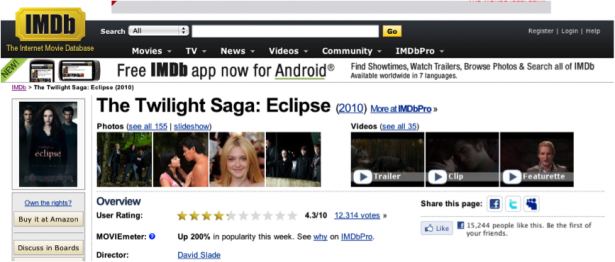At the F8 conference in April, Facebook announced the launch of the “Like” button; a widget that enables users to make connections to pages of a website and share content with their friends. The widget allows users to Like specific content such as news stories, articles and photos; and with a bit more work, the webpage can become a ‘social object’, that when liked gets added to the user’s Facebook profile as an interest (e.g. movies), and allows the owner of the social object to message the user through the Facebook news feed, as if it were a fan page.
The button allows users to like the content without being redirected to Facebook, making it ideal for both brand and user. Brands keep the users on the site and the user’s browsing isn’t interrupted. Since Facebook hosts the content of the widget itself, the button can display personalized content (like how many of the user’s friends also liked the article) whether or not the user has logged into the brands site.
How can it help brands?
The design of the Like button enables brands to harness the viral power of Facebook more effortlessly. The open graph means that brands no longer need to just heap all their content on to fan pages, and can instead allow fans to connect direct to their own websites. Brands, especially those who don’t feel they have content engaging enough for Facebook users, will often be unsure as to how to connect their product with the user. They often feel it necessary to put all of their corporate information onto a fan page, even though most of the information may be fairly irrelevant for the user.
To be social, brands need to be engaging. Posting a load of corporate information on to Facebook isn’t engaging; but in the same way, leaving that on a corporate website and putting in a Like button won’t help much either! People will engage with interesting content, and this needs to be the focus of social. If you naturally have this, like IMDB below, it makes sense to use the Like buttons to allow users to connect directly to your content. If you’re a more traditional brand with an otherwise staid web presence and corporate website, it may make more sense to leave that where it is, and set up a separate fan page on Facebook to focus just on interesting and engaging content you can produce especially for social platforms.
One key feature of the widget is that it allows users to Like individual content, not just brands or pages. If brands have specific information, for example articles on how they are developing or changing, users can Like and share the specific content. When a user clicks on Like a one-line clickable news story is published to the users newsfeed. This link will then in turn also show on the user’s friends’ homepages.
A lot of websites have already adopted the button and seen good results. Mashable reported that TypePad users who installed the Facebook Like button on their blog sidebars experienced a 50% increase in referral traffic from Facebook collectively http://mashable.com/2010/06/13/facebook-like-increases-blog-referral-traffic/.

No Comments Yet
You can be the first to comment!
Leave a comment